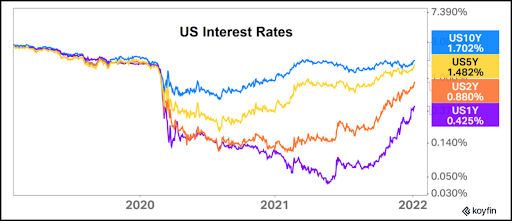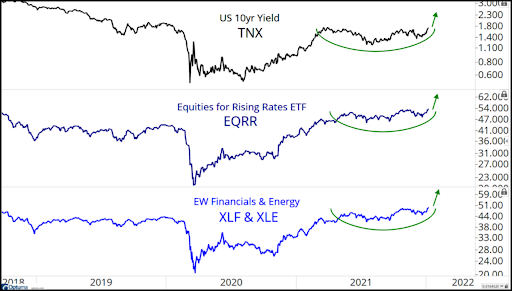Related Blogs
January 10, 2022 | Avalon Team
A lot of investors out there are in for a nasty surprise this year – especially index investors.
Allow me to explain…
2022 is not 2019. It’s also nothing like 2020.
This is a different environment and investors who hope to profit and outperform the market need to recognize and adapt to major shifts, particularly the rise in yields.
U.S. interest rates are making new highs – the 1-, 2-, 5- and 10-Years are all moving higher.

So, it’s time to ask yourself…
“Which stocks tend to do well when rates are rising?”
They aren’t the same stocks that did the best in 2019 or 2020.
Nope, this time it’s the cyclical sectors – think Financials and Energy.
Take a look at the chart below.

In the upper pane are 10-Year Treasury Yields (TNX) moving higher. In the lower pane is a combination of Financials and Energy, equally weighted (XLF+XLE).
You can see the cyclical sectors of Financials and Energy moving in lock-step with U.S. 10-Years.
And here’s a bonus trade idea in the middle pane. It’s a Proshares ETF – Equities for Rising Rates (EQRR). Seriously, it’s a real thing.
EQRR is rising right along with 10-Year yields, just like XLF/XLE. And the reason is simple. Almost 60% of EQRR are Financials and Energy.
Digging even deeper, when you add in EQRR’s exposure to Materials and Industrials, now you’re looking at close to 90% of the entire ETF composed of four sectors: XLE, XLF, XLB, and XLI.
These are the cyclical sectors that tend to outperform in a rising interest rate environment like the one we’re in today. These are the areas savvy investors should be looking at for opportunities.
Think Materials, Commodities, Energy, and other long-forgotten cyclical corners of the market. These pockets are poised to benefit most from an inflationary backdrop that supports global growth.
Now we’re coming full circle to when I opened by saying, “I think many index investors are in for a nasty surprise this year”…
As investors, it’s our responsibility to know what we own. Saying “I own the index” is not good enough. Understand what’s inside of the indexes you own.
Do you know which stocks and sectors drive them higher or lower?
This seems like an afterthought in some circles, especially after the major large-cap indexes have put up nice returns the past three years. It’s easy to become complacent…
But that can be a big mistake as you’ll soon see.
Take the S&P 500, for example, up 28% in 2019, up 16% in 2020 and up 27% in 2021.
Do you know what drove those returns?
Here’s the sector breakdown of the SPDR ETF SPY:
- Information Technology: 28%
- Consumer Discretionary: 12%
- Communication Services: 10%
50% of the entire index is comprised of only three broad sectors.
Names like Apple, Microsoft, Google, Facebook (Meta), Tesla, Amazon, and Nvidia.
But what’s missing? How about the sectors that historically excel in a rising interest rate environment!
Look at the year-to-date chart comparing the 11 broad sectors:

Energy (XLE) has gained 10.52%, while Technology (XLK) is down -4.57%.
So, if you own the S&P 500, that means only 5% of your portfolio is in Energy and Basic Materials.
If you own the Dow Jones Industrial Average, that number drops to under 3% (remember they recently kicked out ExxonMobil from the Dow).
If rates are going higher – and it sure looks like they are – investors should be looking at areas like Energy, Financials, Industrials, and Materials.
Many indexes don’t have exposure to those stocks.
So know what you own. This year is not like last year – or the prior two.
I think this year could be very different.
Energy was the best-performing sector in the U.S. for 2021. Financials did very well too… so this isn’t anything new. I think the trend is actually just getting stronger.
The question is – are you prepared for it?
If you have any questions or have been considering hiring an advisor, then schedule a free consultation with one of our advisors today. There’s no risk or obligation—let's just talk.
Tags

Free Guide: How to Find the Best Advisor for You
Get our absolutely free guide that covers different types of advisory services you'll encounter, differences between RIAs and broker-dealers, questions you’ll want to ask when interviewing advisors, and data any good financial advisor should know about you and your portfolio.

